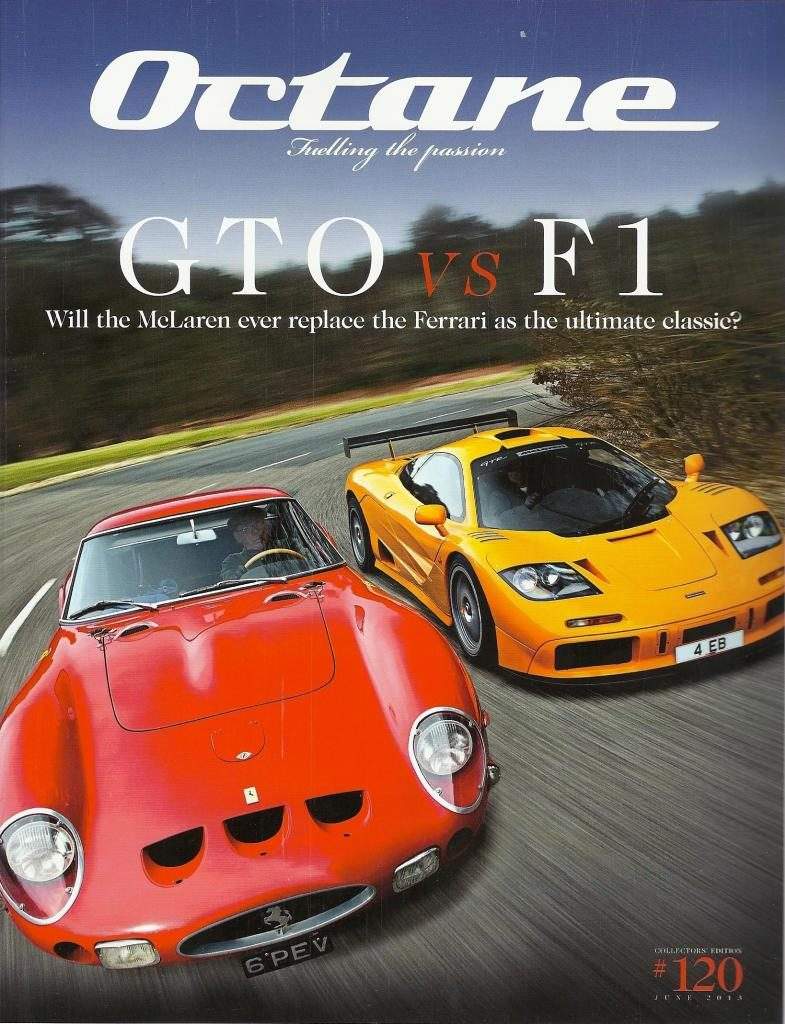Insight McLaren F1 vs Ferrari 250 GTO
Classic CarsCollector's InsightsCollecting & InvestingIn the classic car world there is one undisputed king. It is the 1960s Ferrari 250 GTO.
Sure, there might be more valuable cars out there. I am thinking of a 1920’s Bugatti Royale* that sits in the Schlumpf Museum, or the Bugatti Atlantic 57SC (supercharged) of which there are two known (one belonging to RL, the other sits in the Mullin Automotive Museum in CA). The Ferrari 275 GTB-C speciale that won its class in Le Mans is also rumored to be worth substantially more than any 250 GTO. But there is not a group of cars ever made (I define that as more than 30) that can command average prices of the Ferrari 250 GTO.
The 250 GTO has the looks, the history, the drama, the story and owners club today – that make it the most desirable car on this planet. It is the ‘king among kings’ as one expert has said.
However there might be a new contender for the mighty 250 GTO. Let me explain.
A few weeks ago, a 1995 F1 McLaren sold at auction for a staggering $15.6m. It was a normal road going car not even an LM race version or GTR (the racing versions). How can a car of which more than 100 units were made fetch such a staggering amount? Long before this result – many car aficionados and experts have all been asking the question- if it is fair to compare the McLaren F1 to the mighty Ferrari 250 GTO (Octane magazine already compared the two back in 2013). Even though both cars carry a 30 year age difference – both of these icons have some similarities. So, we have also decided to take a stab at this question:
Can we compare the McLaren F1 a car made in the 1990s to the 1960s Ferrari 250 GTO; and will the McLaren F1 ever fetch the values of a GTO?
Differences between the 250 GTO and F1 McLaren
Before we go into trying to predict the future of both cars; let us state the obvious what the McLaren F1 is and what it is not.
First, although the McLaren can be driven to go to the local bakery (something Simon Kidston admits to doing- see end of report for more info)* and was designed also as a road car – it is first and foremost a road going race-car. The Ferrari GTO, while designed to be clearly a race car was also a dual -purpose car. It could be raced on the track but was equally fitted to go out on a Sunday drive. This is a slight difference between both cars and should be stated clearly in the beginning. As James Cottingham of DK Engineering who has driven an F1 McLaren says, ‘as a race-car it involves feel, it is by no means an easy car to drive, the steering is heavy, it is a real drivers car that wants to be driven hard and fast’.
The second difference between the F1 McLaren und GTO is the production numbers and type of car. To start with the McLaren built almost 3x more cars than the GTO. A total of 106 were made (of those 64 of them were road cars) versus 36 GTO’s (or 39 depending if you include three of the 330 made). So alone in terms of supply it is difficult comparing the two when there are 300% more F1’s are out there versus the 250 GTO.
A third difference that needs pointing out is that the F1 is not entirely McLaren. Yes, the engineering was McLaren but the engine base comes from BMW M racing division (who supplied a V12 engine). With the 250 GTO it was pure Ferrari. The engine of course being the infamous Colombo – engine V12 developed by Ferrari, and the chassis design also remained in – house with the 250 GTO (not a given as Ferrari liked to leave the design to others like Pininfarina, Vignale, Zagato etc) and concentrate on the engine. Many great Ferrari’s were not designed in- house (like the 250 SWB, 275 GTB, Dino, 250 Cabriolet Series 1). So the fact that the 250 GTO was designed, made and built by Ferrari all in – house distinguishes the car from the F1 McLaren.
The fourth and most obvious difference: the F1 is a different generation supercar. Being built more than 30 years later, the F1 is full of technology making it a completely different animal to drive, use and maintain versus the GTO as ‘the vintagehour‘ correctly points out. It might be fair to even ask: How can we even compare two cars that are more than 30 years apart in age?
Some similarities exist between both cars
While it would be naive and silly to compare the cars in terms of performance or technology – the cars do show some similarities in terms of purpose and success.
Both were designed to win races and compete and both show a track record of success. The McLaren F1 won Le Mans in 1995 and is still the fastest naturally aspirated road car ever made and tested – not bad for a car made 25 years ago. The 250 GTO Ferrari never won Le Mans outright (it did come second) but did win its GT class in 1962 and 1963. For that the 250 GTO won other notable rally’s and races which included Goodwood tourist trophy, the legendary Tour de France (which it won in 1963, 1964), the Targa Florio GT class wins in 1962, 63 and 1964 and lastly Nurnburgring in 1963. The 250 GTO was the best rally/race car of its day. Nothing could beat it and nothing did.
It might be fair to say that the 250 GTO was a more versatile car winning both rallies and races. The GTO was designed with beating the competition in mind and it did but so was the McLaren F1. As Gordon Murray, the designer of the F1, stated ‘it was my attempt to build the best engineered drivers car ever’. Both cars the F1 McLaren and GTO are considered among the best engineered cars of their day.
Why is that? What do both of these cars have, that made them so successful?
I think it has to do with another point that both the McLaren and GTO share: Both cars were developed using racing technology.
Ferrari was well known already back in the 1960s to making road cars simply to finance their race-cars. Ferrari’s primary interest never lay with the road cars but rather with racing – that was the true passion of Ferrari, the company, and the founder Enzo Ferrari. His road cars simply brought in enough cash to finance their racing department. The 25o GTO was developed using Ferrari’s know-how in the racing department and was an evolution from the 250 SWB – itself a legendary car for Ferrari.
The McLaren F1 is no different. In fact, although it was allowed as road car, the McLaren F1 is more of a race- car (of the total 106 built nearly 40 McLaren were pure race cars and not allowed for the road). The McLaren F1 used the latest technology from its racing department, and as the name suggests, McLaren has a long history with racing and formula 1. The McLaren was the first road car made completely out of carbon fibre (the entire chassis is carbon fibre). This made it very light and enabled it to deliver the performance that made it such an Icon it is today.
It is thus not surprising that quite a few collectors own both the Ferrari 250 GTO as well as the McLaren F1. Ralph Lauren, Nick Mason, Charles Nearburg are just several collectors that own both cars (according to some dealers there are at least 5 – 6 collectors that own both cars). Not a bad statistic given that only 36 GTO’s were ever made. In other words 13-15% of GTO owners also own a McLaren F1. Is it pure coincidence or is it because there is a rational reason behind it and both can be compared as the super cars of their respective era.
The last point both cars share: both are part of an exclusive drivers club that do regular tours. The 250 GTO owners are part of an elite club that go on tour. Similar for the McLaren F1, which just did a 25 year anniversary tour recently this year (McLaren is known in supporting their drivers of road cars with technicians).
So, what does the future hold for both cars in terms of status?
Price developments of both cars
Let’s give the McLaren F1 credit. This is a car that was made in the 1990’s and 25 years later can still hold the title of being THE king of the Supercars.
The F40 (of which 1311 were made) was also a 1990s supercar but it cannot match the status of the McLaren. The Porsche 959 is also an iconic car and in its time was the fastest production car ever made. Granted it was made in the 1980s and although was made in more quantities than the F1 McLaren (over 337 were made), it also cannot match the McLaren today, not in terms of top speed, not in terms of racing history and not in terms of price developments.
Collectors today are regarding the McLaren F1 as the best super car ever made after 1980. In fact they are valuing the car as one of the best cars ever to leave the factory of any car maker. The McLaren F1 has even overtaken some of the greatest classic cars ever made including the 250 SWB. Back in 2013 you need a million or two in cash plus a McLaren F1 to buy a 250 SWB. Today it is different. Even if you think the last sale of the McLaren F1 is not representative of the other road cars (it was a unique car in that it was the first US road model allowed in the US) – it takes at a minimum $5m plus a 250 SWB to buy a McLaren F1 today. At the level of say $13-15m today the McLaren F1 has entered the territory of a 250 SWB alloy car or competition version, a Jaguar D type with superb racing history or a DB4 Zagato Aston Martin. In other words – a McLaren F1 today is at the same level price wise as the most collectible cars on this planet. The price development of the F1 has been astonishing considering that only a decade ago these cars were trading for $1m.* Only in 2014 did an F1 break the $10m mark (according to Autoweek). Not even a GTO can claim a 14x fold increase in the past decade.
With these crazy price developments – it is fair to ask is all this sustainable? Does the F1 have staying power or is the McLaren profiting from the super car trend that has been going now for a while in classic cars. The trend of supercars like Enzo, Porsche 959 and lightweight 993 and 964 becoming the toys of the current generation of 40 year olds that can relate to the cars of their youth. In that respect the F1 has staying power. The F1 McLaren is the GTO of the internet and start up generation of young billionaires. It is the new future classic collectible for this new generation of collectors as ‘thevintagehour‘ points out.
It is no surprise that many are even asking: can the McLaren F1 one day overtake the king of them all: the Ferrari 250 GTO in terms of price?
(For more on the price developments of the F1 McLaren please see charts below).* Credit: The vintage hour and Hagerty.
Ferrari has one big advantage over the McLaren: History and heritage
To answer whether the F1 McLaren has what it takes to step into the same league as the 250 GTO – lets look at what the GTO has that the McLaren lacks.
We talked about the racing history. But the GTO has a few other things going for it that make it unique:
The 250 GTO was designed when Ferrari was at the top of its game. It had the best engineers (Colombo, Lampredi, Bizzarini), best designers (Pininfarina, Vignale, Zagato), it had produced the most beautiful road cars (250 SWB, 410 Superamerica, the best racing cars (250 LM, 250 TDF, 250 Testarossa). It had the genius Enzo Ferrari who just ousted his best people out of fear they were not being loyal to him and yet Ferrari still managed to build one of the greatest cars of all time: the 250 GTO. Lastly the 250 GTO was built when Ferrari had the best racing drivers in the world race for them: Fangio, Gendebien, Von Tripps, Muso, Phil Hill, Castelloti – you name it – they all drove for Ferrari.
In other words Ferrari was on top of the world when it produced perhaps its greatest car ever. And the 250 GTO would help enable Ferrari to win the world championship title from 1962, 1963 and 1964. This heritage and history of Ferrari is what makes the 250 GTO so great.
Can the F1 McLaren match that? Of course not.
Before the F1, I don’t think McLaren produced a road car at all. Also I think it is fair to ask: what has McLaren delivered after the F1? Nothing outstanding in my opinion (ok the P1 was not too bad but it was not world class either) but compare it with Ferrari who brought out some of the most beautiful cars after the 250 GTO which include the 275 GTB, the NART version, the 206 Dino, the P4, the Enzo and LaFerrari only to mention a few masterpieces. So it seems McLaren had the stars line up with the F1. They had no history before and not much greatness has come out of the factory since either – at least not on the level of an F1 car.
Ferrari is different. It was on top of its game when the GTO came out and after the GTO it made some of the greatest cars ever. This is the major and important difference between the two cars and companies. This is why, in my view, the F1 will never catch up to the 250 GTO. Not in terms of price at least.
The last public auction of a 250 GTO yielded $38m in 2014 but last year in 2016 – Simon Kidston sold a 250 GTO Ferrari that exceeded that amount by a long shot (there is speculation that it was near the $50m mark). You need about 3 normal F1 McLaren cars to buy a 250 GTO today. This gap will not close anytime soon.
Closing thoughts
There is no doubt the F1 McLaren is a great car.
It is for many the best supercar ever built since the 1980s. The middle driving seat is unique in the car world, and the ground-breaking engineering that went into the F1 will no doubt appeal to many collectors – ensuring the McLaren F1 will remain highly collectable.
The F1 McLaren is at the right time at the right place in terms of collectability and future price potential. As Simon Kinston argues: ‘In a collecting world were the buyers are getting younger and younger and their tastes evolving accordingly, the F1 has a rosy future. And yes for the combination of everything I mentioned above, it lives up to it’s star billing. Other supercars are great but the F1 is the greatest.’
I think Simon is right. Among the supercars from the 1980s onwards the F1 is the king. It is the greatest and the market has rewarded it for that. But if you compare it to 250 GTO – the F1 lacks in one critical department: Heritage and history.
In my view the history and heritage of Ferrari almost ensures that the 250 GTO will remain the most collectible car for the foreseeable future. No car that was made in more than 10 pieces can match the GTO. Not in terms of price. Not in terms of historic importance. Not in terms of beauty either (agreed this is subjective)
As a James Cottingham of DK Engineering has told me on the phone. ‘There is only one car in this world that is the ‘king’ of the kings. It is the 250 GTO’.
*For Simon Kidstons experience in driving and owning a McLaren F1 he says the following:
‘Does the F1 justify its towering reputation? Lift the door and there it is, the central driving seat. Flick the ignition cover back and hit the red button. No fuss, no fake noise, no silly dashboard messages. 12 cylinders whirr into life at an even idle. Slot the lever into first, no accelerator needed and lift the clutch. Your off on a magic, race bred carpet ride. Grocery shop? Easy, I collect croissants on Sunday mornings with it. Autobahn missile? I’ve seen 350km/h. Gstaad for lunch? You’ll lose your license but the memory will put a smile on your face’.
**(Credit: MotorAuthority). Main picture credit: Simon Kidston. Special thank you to Simon Kidston, James Cottingham of DK Engineering, and Steve McHour of the the vintage hour for their insights.
Below the McLaren Owners Club 25 anniversary tour taken earlier this year (Credit:McLaren F1 owners club).
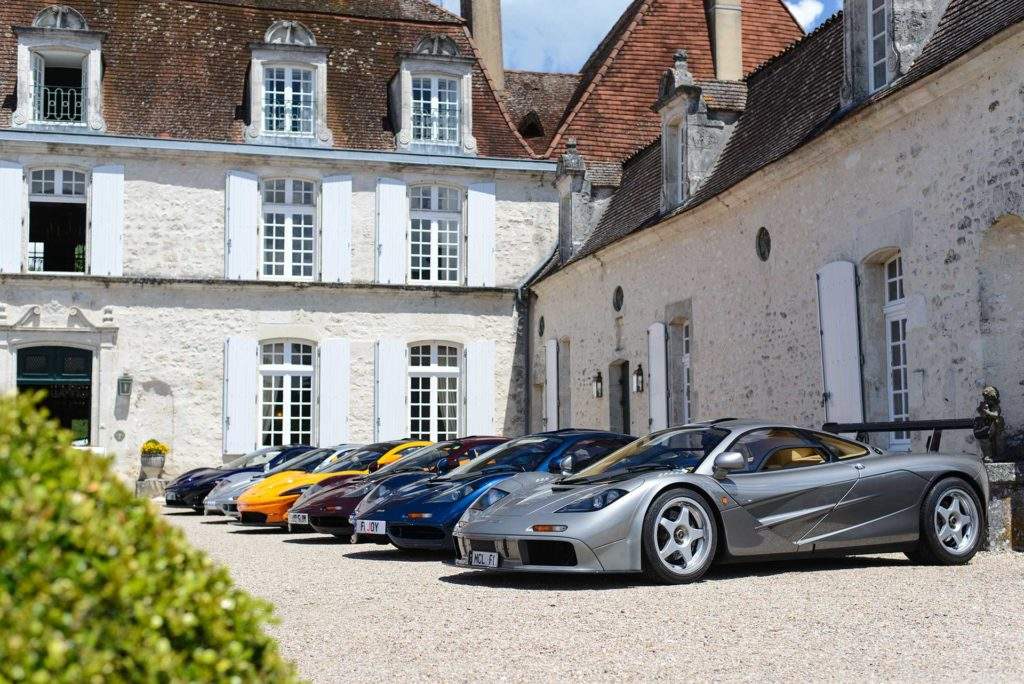
Below the 250 GTO Anniversary tour in 2012. (Credit: Nicolas Jeannier – Arthomobiles).
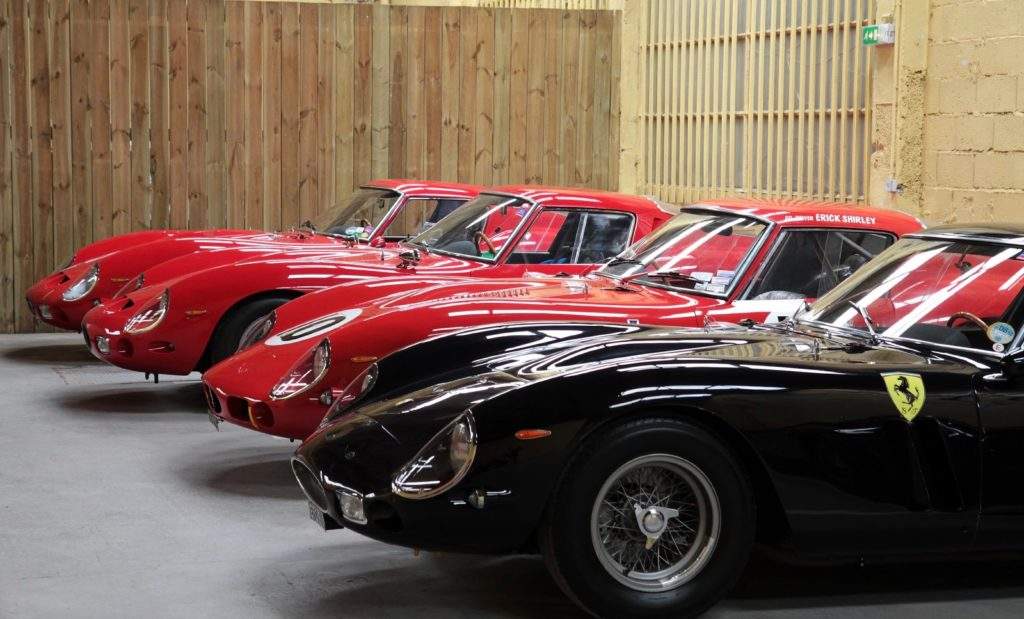
Another picture of the GTO Anniversary tour in 2012. (Credit: Nicolas Jeannier – Arthomobiles).
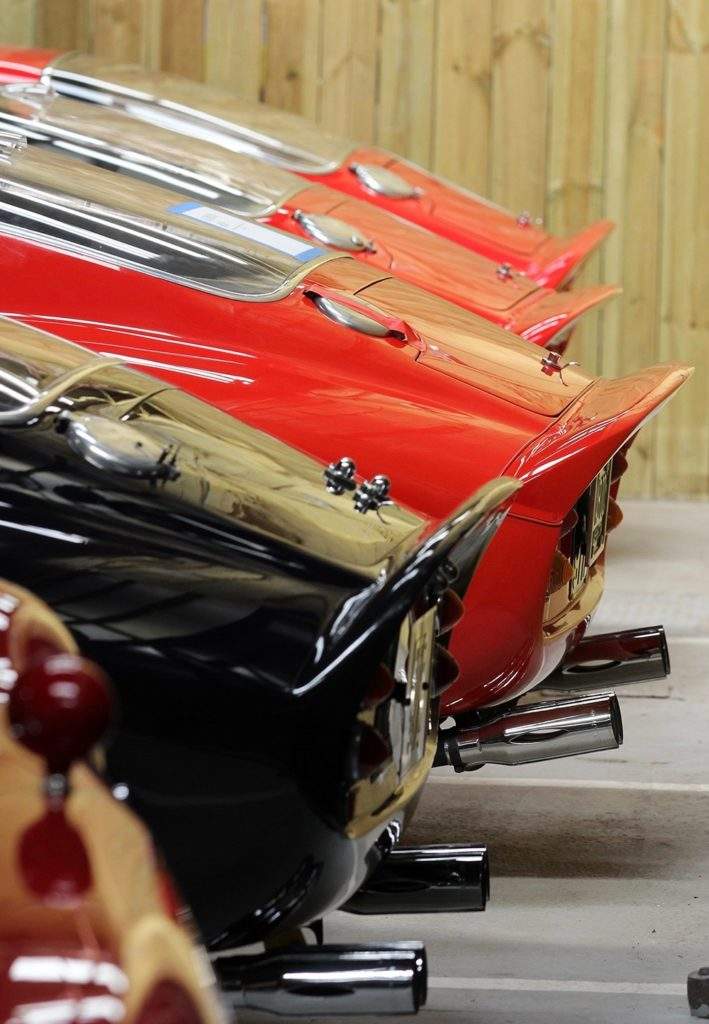
In terms of price developments no car can catch the F1 over the past decade. Both the F1 and F1 LM have risen more than 10x in the past decade outperforming the Supercar Ferraris like F40 or 288 GTO and Enzo. See chart below. (Credit: The vintage hour / Hagerty).
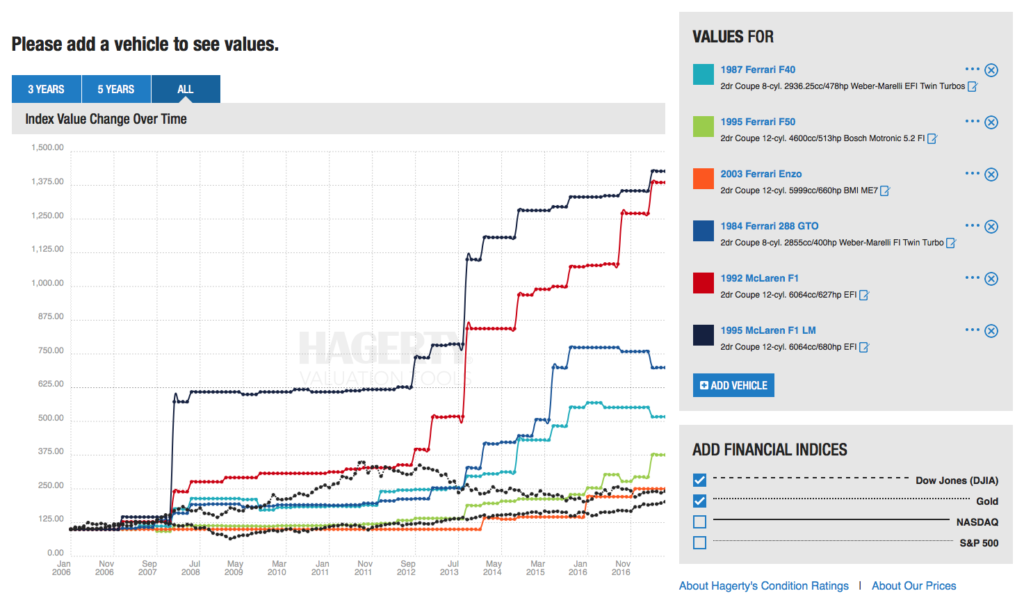
Even comparing to blue chip classic cars like the 275GTB, Miura SV and 250 GTO – the LM has been far superior over the past decade. (Credit: The vintage hour /Hagerty).
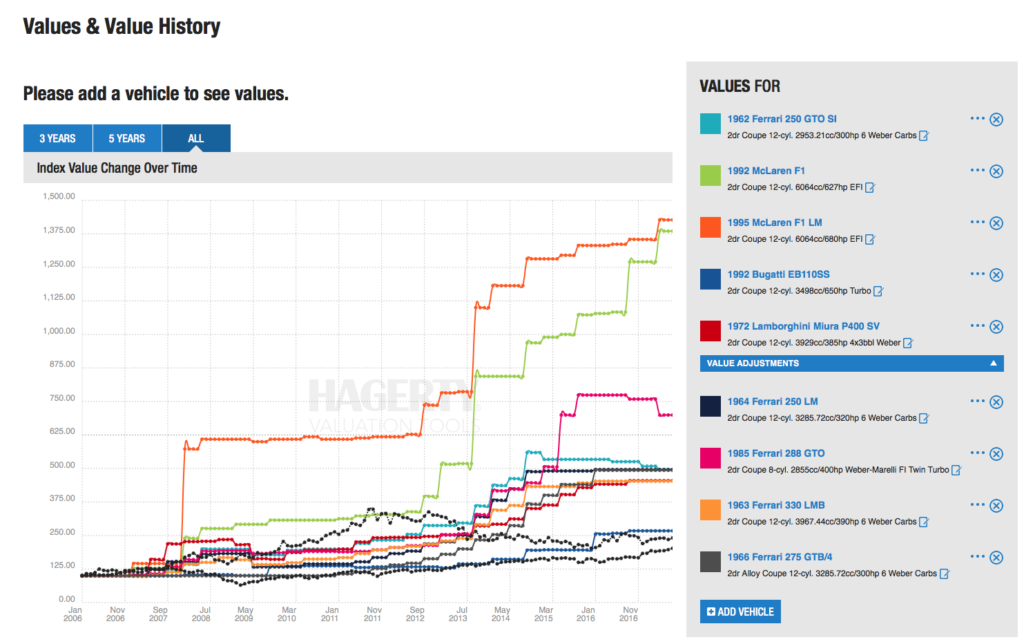
Simon Kidston in his McLaren F1, notice the middle seat.

For those interested in further reading buy the 2013 Octane cover story of the F1 McLaren versus the 250 GTO Ferrari.
